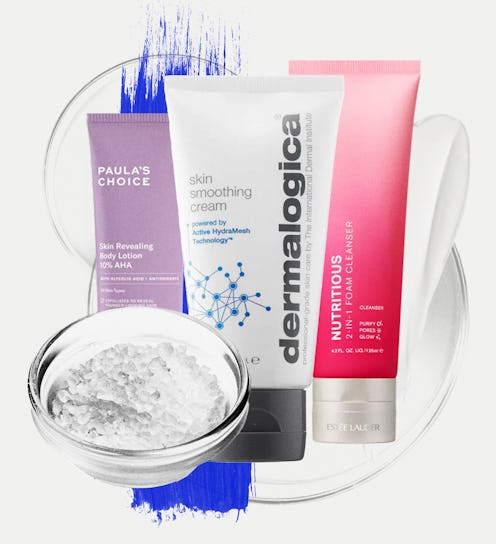(Back To Basics)
This Fatty Acid Is The Sleeper Ingredient In Your Favorite Moisturizing Products
The true workhorse of skin care.

With new products, brands, and categories popping up every day, beauty can be a bit overwhelming. Back to Basics is our rudimentary beauty series that serves as your crash course on the science behind some of the best formulations in the game. This week, we’re taking a look at stearic acid for skin.
When it comes to skin care, active ingredients are the cream of the crop. They target issues like wrinkles, loss of collagen, hyperpigmentation, and more. While they certainly provide results and help you achieve your skin goals, they don’t do it alone. To create an effective product, you need builder ingredients. These are the supporting elements that shape the formula and, in turn, allow the actives to do their job. Though it doesn't usually get the spotlight, stearic acid is a star structural ingredient. Found naturally in shea and cocoa butter, the benefits of stearic acid for the skin are vast and significant.
As a popular emollient that soothes and softens skin, it’s added to a range of products and is used to enhance their formulations. It’s commonly added to creams, lotions, and even cleansers, explains Dr. Cula N. Svidzinski, M.D., board-certified medical and cosmetic dermatologist at Sadick Dermatology in New York City. “It has incredible moisture-locking properties, but it also acts as a surfactant — helping to dislodge and wash away excess oil and dirt from the skin’s surface,” she says. Stearic acid is also a thickening agent that improves a formula’s consistency and spreadability.
You may not be familiar with the name, but you’ve likely come across a product containing stearic acid. Below, TZR taps two dermatologists and a cosmetic chemist to learn about the ingredient’s benefits and the best way to incorporate it into your routine.
What Is Stearic Acid?
Stearic acid is a common fatty acid found naturally in animal and vegetable fats. More specifically, Dr. Svidzinski explains that it is a long-chain fatty acid with a soft, waxy texture. While stearic acid is most commonly extracted from natural sources, there are synthetic versions. “As a corneum (the outer-most layer of skin) lipid, it’s extremely moisturizing and an important component of our skin barrier,” she says. It occurs in a variety of plant oils — most notably shea butter and coconut oil — and is thus most frequently used as an emollient. “Not only does it help lock in moisture, but it helps soften the skin,” she says. The protective layer also decreases water loss and ensures absorption of key ingredients.
What Are The Benefits Of Stearic Acid?
There’s no denying the moisturize-locking benefits of stearic acid. Found naturally in organic substances like shea and cocoa butter, it seals in water and softens rough areas. Dr. Serena Mraz, M.D., board certified dermatologist of Solano Dermatology and Associates in Vallejo, Calif., notes it’s extremely beneficial during the colder months when your skin is more susceptible to dryness. Accordingly, it helps strengthen the skin barrier and can even soothe an inflamed patch from eczema or other skin conditions. “Products containing stearic acid are great for moisture retention and for counteracting mildly irritated or inflamed skin,” she says.
Beyond its moisturizing abilities, stearic acid is most beloved as a structural agent. According to Joyce de Lemos, clinical cosmetic chemist and co-founder of Dieux Skin, stearic acid isn’t regarded as an active ingredient but more of a builder. “It usually exists within a formulation to aid with emollience and consistency of the product’s formulation,” she says. Stearic acid is a common component of creams containing other emollient ingredients such as castor and grapeseed oil. As a richer agent, it enhances not just a formula’s texture, but also its anti-inflammatory properties. Soaps and shampoos also frequently use the fatty-acid to boost their cleaning and moisturizing properties.
Who Should Use Stearic Acid & What Are Its Potential Side Effects?
Despite occurring naturally, Dr. Svidzinsk explains that the purest form of stearic acid can irritate the skin. But when blended in formulations, she tells TZR that it’s well tolerated by most skin types. “Given its moisturizing properties, stearic acid is ideal for those with sensitive and dry skin,” she says.
Still, it’s best to proceed with caution, as any new skin care product has the potential to cause an adverse reaction, especially if you have existing food allergies. Since stearic acid is derived from plants and animals, it can trigger those allergens. “Coconut oil is an ingredient that many people are allergic to, and it’s also one of the possible sources of stearic acid,” says Dr. Mraz. That said, it’s best to research new products ahead of time or consult your dermatologist before use.
How To Incorporate Stearic Acid Into Your Routine
Stearic acid can be found in an array of products. From shampoos to creams and face or body washes, there are many ways to reap its benefits. Furthermore, you won’t have to add an extra step to your routines. The key is to look for skin or hair care items that contain the ingredient. If you’re having trouble finding one, consider the list below a good place to start.